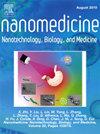SERS liquid biopsy in colorectal cancer detection and treatment response: Revealing metabolic memory post-radiochemotherapy
IF 4.6
2区 医学
Q2 MEDICINE, RESEARCH & EXPERIMENTAL
Nanomedicine : nanotechnology, biology, and medicine
Pub Date : 2025-06-26
DOI:10.1016/j.nano.2025.102840
引用次数: 0
Abstract
This study investigates the potential of using surface-enhanced Raman scattering (SERS) serum analysis to assess the response of rectal adenocarcinoma (READ) patients to preoperative radiochemotherapy (RCT). A univariate classification approach differentiated RCT responders (R) from non-responders (NR) with 73 % accuracy. In addition, a classifier trained to differentiate colon cancer from healthy controls was independently applied to the R and NR groups. Using this model, Random Forest identified 86 % of NR samples as cancerous, aligning closely with histopathological findings. Notably, the SERS metabolic profile of the majority of the R sample more closely resembled that of cancer pathology than of healthy controls, suggesting the presence of residual cancer-related metabolic activity, despite the diagnosis of near complete tumor regressions based on histopathology. This user independent classification approach underscores the potential of SERS-based clinical spectroscopy as a non-invasive support tool for predicting tumor response in colorectal cancer.

SERS液体活检在结直肠癌检测和治疗反应中的应用:揭示放化疗后的代谢记忆。
本研究探讨了使用表面增强拉曼散射(SERS)血清分析来评估直肠腺癌(READ)患者对术前放化疗(RCT)的反应的潜力。单变量分类方法区分RCT应答者(R)和无应答者(NR),准确率为73% %。此外,R组和NR组分别使用经过训练的分类器将结肠癌与健康对照区分开。使用这个模型,随机森林确定了86 %的NR样本是癌性的,与组织病理学结果密切一致。值得注意的是,与健康对照相比,大多数R样本的SERS代谢谱更接近于癌症病理,这表明存在残留的癌症相关代谢活动,尽管基于组织病理学诊断为肿瘤几乎完全消退。这种用户独立的分类方法强调了基于sers的临床光谱作为预测结直肠癌肿瘤反应的非侵入性支持工具的潜力。
本文章由计算机程序翻译,如有差异,请以英文原文为准。
求助全文
约1分钟内获得全文
求助全文
来源期刊
CiteScore
11.10
自引率
0.00%
发文量
133
审稿时长
42 days
期刊介绍:
The mission of Nanomedicine: Nanotechnology, Biology, and Medicine (Nanomedicine: NBM) is to promote the emerging interdisciplinary field of nanomedicine.
Nanomedicine: NBM is an international, peer-reviewed journal presenting novel, significant, and interdisciplinary theoretical and experimental results related to nanoscience and nanotechnology in the life and health sciences. Content includes basic, translational, and clinical research addressing diagnosis, treatment, monitoring, prediction, and prevention of diseases.

 求助内容:
求助内容: 应助结果提醒方式:
应助结果提醒方式:


